Results – Thermal Data
We tested three fan speeds and three flow rates as we were intrigued just how things changed with flow rate as we had never seen it tested before. Each individual radiator’s specific detailed thermal test data will be featured in their individual review. But we’ve included one example here to try and help give perspective on the numbers and results before we launch into the big round-up wide comparison. So let’s take the EK XE 360 as an example: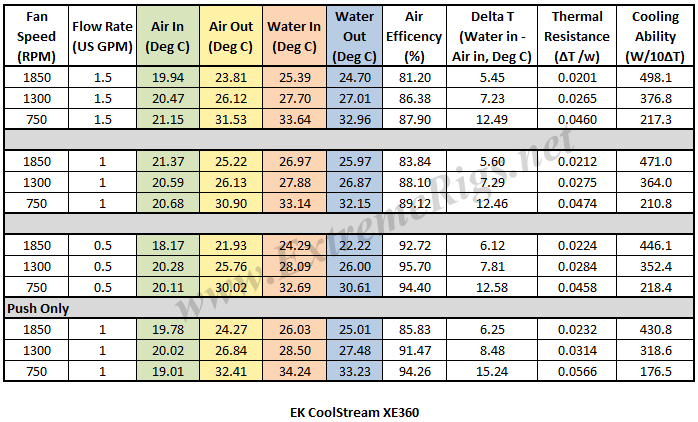
Above is the final data results gathered from at least 2 data logging runs at each flow rate and fan rpm combination. The most stable 15 minute period from each logging run was used and then averaged with the other runs to obtain the data for the table below. A total of 16 temperature sensors were used in the thermal test chamber (8 air in, 2 air out, 3 water in, 3 water out) each take a reading every second and logged via a CrystalFontz unit. The data in the table above is the result of the logging runs which has then been used to create all the plots and tables there-after.
Like the vast majority of the other radiators tested, the XE 360 cares little about flow rate, particularly above 1.0GPM. Here are some plots to show the variance:
So the performance is not greatly affected by varying flow rate. However Delta T is not always helpful when thinking about how many radiators you would need to cool your system. Instead it’s more useful to know the delta/W, or more usefully, the inverse metric of W/delta C. This also enables us to calculate the power dissipation and take out secondary effects such as pump power variance and system power losses that might vary with flow.
The metric plotted below tells us how many watts are dissipated by the radiator when the coolant rises 10C above ambient temperatures. (10 Delta T):
As expected increasing fan speed and therefore airflow through the radiator is the primary determinant in changing the radiators performance. This data can now be plotted as a pretty curve so that an end user can interpolate their own fan speed. Note again that the extrapolation of the curve is much more sensitive to error than in between the tested range.
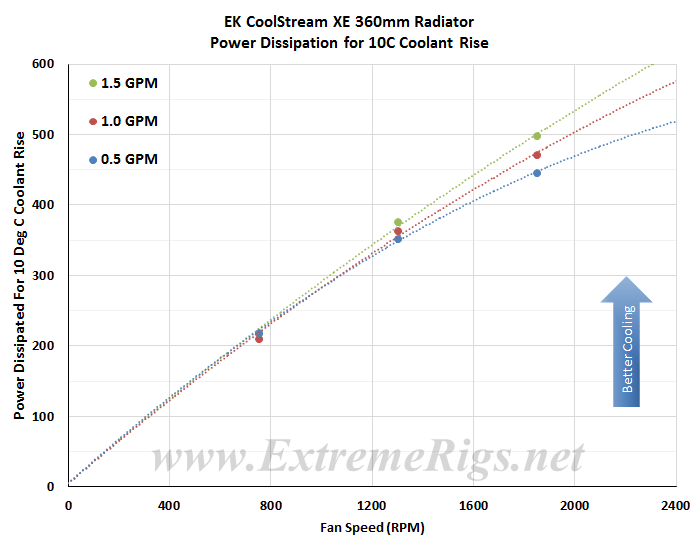
This makes it easier to see that at higher fan speeds that a low flow starts to impact the cooling performance. This makes sense if you take it to the extreme and think about a very low flow rate where the coolant is already cooled 99% of the way to ambient with 10% of its journey through the radiator. In this extreme example the radiator is not being efficiently used. 90% of the radiator surface area would then be wasted and you could have used a smaller radiator. Nearly every radiator performed the same way, i.e. at the air flow rates of interest increasing flow above 1GPM does not seem to help or hurt the radiator performance. However dropping to 0.5GPM can show some loss of performance at high airflow.
Lastly we can also compare the Push Only to Push/Pull results at 1GPM:
Each radiator had a different split in performance between push and push/pull depending on it’s own air restriction.
So now that we understand what the results are for one radiator let’s analyze that data by comparing to other radiators in a variety of ways.








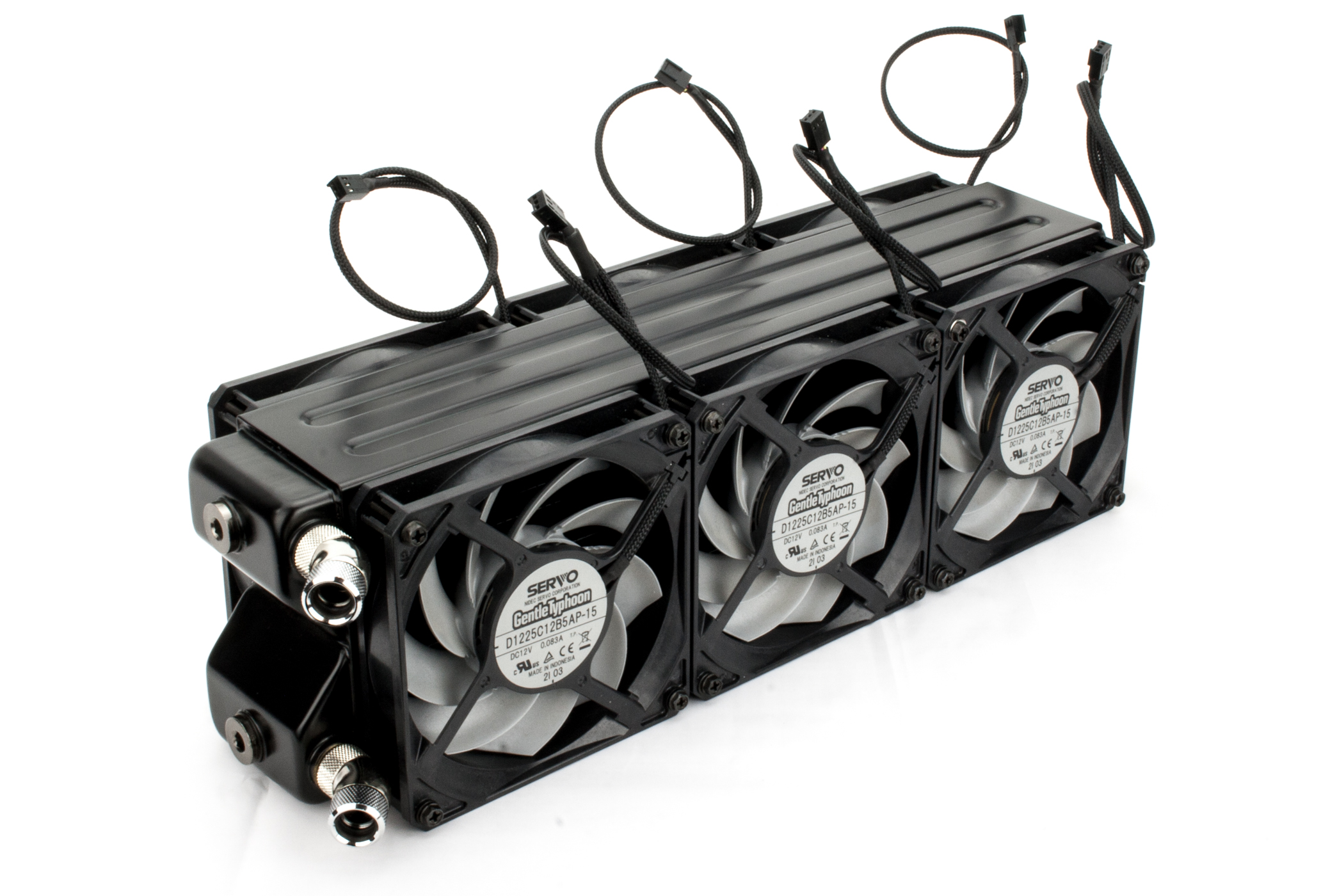
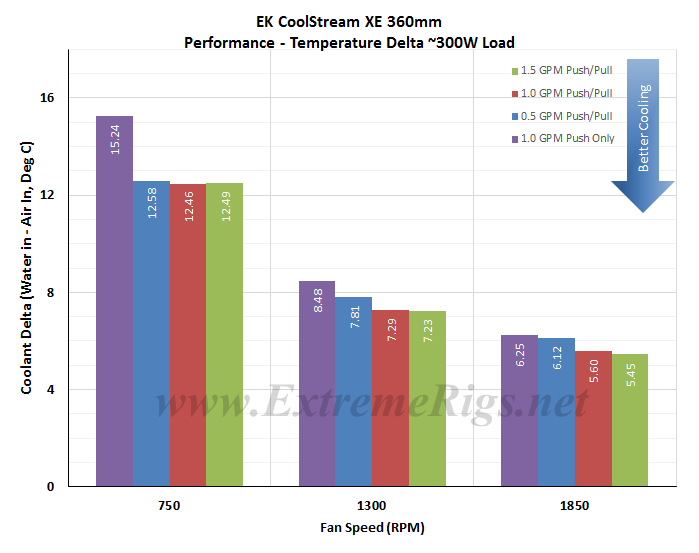
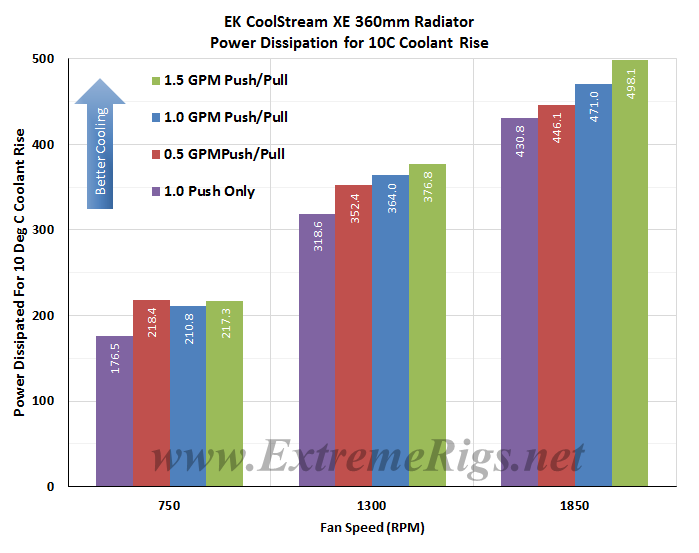
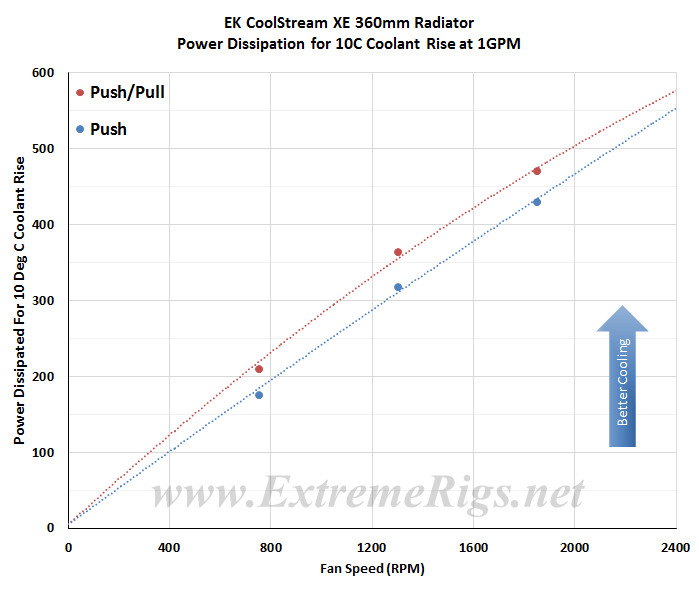



Great Work … a new standard for radiator testing.
The Koolance was a surprisingly good result. Push pull makes a bigger difference than many think.
I’m happy my EK PE rads did OK, mostly keeping up with the XT45 rads they replaced.
The extra 5mm the PE rads allowed made the difference between push only and push pull for an overall better result
Yeah the huge shrouds on the PE mean that it’s really a slim radiator core tucked into the body of a medium radiator wrapper. I do wonder if reducing the shrouds would have made no real change in performance but would have meant it could have won a slim award!
Also not sure what you mean about push only – we haven’t tested one set of fans yet
I meant in my system
This is the best radiator test review I´ve ever seen, great job, guys!
[…] we published the 2015 Radiator Round Up data, there was some pushback from quite a few different manufacturers claiming our use of […]
[…] information and performance data about the Mayhems Havoc 360mm Radiator for inclusion in the Extreme Rigs Rad Round Up 2015. I’ll be keeping the review section short and factual, focusing on presenting the performance […]
[…] […]
Weighing in a bit late, but I just found this article (and the site). This was a great read! Thank you for doing this type of thing. There are many of us out there who want to upgrade, add to, or change our rigs completely. In depth articles like this are the life-bread for us regular folk to gather REAL information.
I do have a question and of course am hoping you find this comment: How about testing the XSPC AX series radiators? I don’t know how you get your samples, but it would be interesting to see how they perform against the rads in this test.
More fan tests would be a wonderful thing as well. Enermax has had the UCTP12P High Static Pressure PWM 120mm Fan out for some time with no virtually no information anywhere as to their validity for use a radiator fan. I noticed you folks have a pre-production sample Vardar from EK. I look forward to seeing how that plays out in production.
Yes we wanted to test the AX series too! We are planning to do more fan tests also
[…] and performance data about the HardwareLabs Nemesis 360 GTS Radiator for inclusion in the Extreme Rigs Rad Round Up 2015. I’ll be keeping the review section short and factual, focusing on presenting the performance […]
[…] is to provide information and performance data about the EK XTX 360mm Radiator for inclusion in the Extreme Rigs Rad Round Up 2015. I’ll be keeping the review section short and factual, focusing on presenting the performance […]
[…] a lot on radiator that which i should get for… i found a great… probably best… article at Radiator Review Round Up 2015 – ExtremeRigs.net you can notice that coolgate g2 radiator is really great radiator for both performance and […]
[…] information and performance data about the XSPC EX360 v2 360mm Radiator for inclusion in the Extreme Rigs Rad Round Up 2015. I’ll be keeping the review section short and factual, focusing on presenting the performance […]
[…] information and performance data about the Alphacool UT60 360mm Radiator for inclusion in the Extreme Rigs Rad Round Up 2015. I’ll be keeping the review section short and factual, focusing on presenting the performance […]
[…] information and performance data about the Alphacool Monsta 360mm Radiator for inclusion in the Extreme Rigs Radiator Round Up 2015. I’ll be keeping the review section short and factual, focusing on presenting the performance […]
Hey fast nate
i was wondering how close you are to finishing the radiator roundup with just the push fan setup? thanks man
Hey Mike – Stren here, fast_fate is working hard but there’s probably still a few more weeks to go. For the most recent push data take a look at the Monsta review which has the “so far” data:
https://www.xtremerigs.net/2015/03/25/alphacool-nexxxos-monsta-360-radiator-review/6/
[…] We expect the performance to be identical to the current version as only the port options appear to be different. We’ll be getting this one into the thermal test chamber for some performance scrutiny very soon so look forward to a full review soon and inclusion into the Rad Review Round Up 2015. […]
[…] […]
Well, I think that the reviewers always get a mint rad. I already had to send back a Phobya G-ghanger 360 V2, a Phobya G-canger 420 V2, a Alphacool UT 60 420 , a Coolgate CG360CG2 and a Coolgate CG480CG2 , this because of heavy paint faults, scuff marks on the side panels , matt grey spots where paint is of, and the phobya 420 had a piece loose inside the rad. Al bad rads and these al got delivered and send back the last 2 months. The brands are asking good money, but deliver bad quality.
[…] about the Aqua Computer AMS (Airplex Modularity System) Copper 360mm Radiator for inclusion in the Extreme Rigs Rad Round Up 2015. I’ll be attempting to keeping the review section short and factual, focusing on presenting the […]
[…] provide information and performance data about the HWLabs SR2 360mm Radiator for inclusion in the Extreme Rigs Rad Round Up 2015. I’ll be keeping the review section short and factual, focusing on presenting the performance […]
[…] information and performance data about the Phobya G-Changer HPC 360mm Radiator for inclusion in the Extreme Rigs Rad Round Up 2015. I’ll be keeping the review section short and factual, focusing on presenting the performance […]
[…] is to provide information and performance data about the EK XE 360mm Radiator for inclusion in the Extreme Rigs Rad Round Up 2015. I’ll be keeping the review section short and factual, focusing on presenting the performance […]
I just posted this same comment on the other review for the Coolgate CG-360G2. I want to thank you for this extensive and extremely detailed review; an updated version to SkinneeLabs.com’s review and Martinliquidlab’s review on radiators (found here: https://martinsliquidlab.wordpress.com/category/radiators/). I was debating (as I’m a reseller for Koolance), weather or not to purchase the Koolance HX-360XC product or the Coolgate CG-360G2. As a result of your thorough testing I’m going to go with the Coolgate CG-360G2. I know you mentioned that it’s hard enough to put just one of these bad boys in your CaseLabs PC Case, but I’m going to put TWO of them in. My config will be set up like this:
25mm Fan/65mm Rad/25mm Fan/65mm Rad/25mm Fan = 205 (sandwiched together side by side)
Which will just cover the bottom of the width of my Origin Genesis PC Case. I’ll post the results later in a couple of months once I’m finished with my (hopeful) new Hackintosh build. We’ll see what happens. Again, thank you for your help. Greatly appreciated !!!
[…] is to provide information and performance data about the EK PE 360mm Radiator for inclusion in the Extreme Rigs Rad Round Up 2015. I’ll be keeping the review section short and factual, focusing on presenting the performance […]
[…] information and performance data about the Koolance HX-360XC 360mm Radiator for inclusion in the Extreme Rigs Rad Round Up 2015. I’ll be keeping the review section short and factual, focusing on presenting the performance […]
[…] information and performance data about the Watercool HTSF2 3 x 120 LT radiator for inclusion in the Extreme Rigs Rad Round Up 2015. I’ll be keeping the review section short and factual, focusing on presenting the performance […]
[…] is to provide information and performance data about the XSPC EX360 Radiator for inclusion in the Extreme Rigs Rad Round Up 2015. I’ll be keeping the review section short and factual, focusing on presenting the performance […]
[…] to provide information and performance data about the XSPC RX360 v3 Radiator for inclusion in the Extreme Rigs Rad Round Up 2015. I’ll be keeping the review section short and factual, focusing on presenting the performance […]
[…] information and performance data about the Alphacool ST30 360mm Radiator for inclusion in the Extreme Rigs Rad Round Up 2015. I’ll be keeping the review section short and factual, focusing on presenting the performance […]
[…] and performance data about the Aqua Computer Radical2 Copper 360mm Radiator for inclusion in the Extreme Rigs Rad Round Up 2015. I’ll be keeping the review section short and factual, focusing on presenting the performance […]
[…] provide information and performance data about the HWLabs GTX 360mm Radiator for inclusion in the Extreme Rigs Rad Round Up 2015. I’ll be keeping the review section short and factual, focusing on presenting the performance […]
Looks like the review is complete! Kudos!
Yeah, I can guess how much it took to go through this painstaking review of 27 (!) radiators, and 486 (OMG!!!!) tests – and that so accurately and reliably. My greatest respect to you fast_fate, and all those who helped you on it.
Needless to say, we are all missing the XS-PC AX360. Could you reach out to XS-PC and ask for a sample maybe? Or get a retail one? Anyway, we are all looking forward to that.
The Round Up will never be complete….
Thanks for following along through the journey.
It is a massive task to update, too much work to keep updating the individual reviews……
which is why we had to make the decision to not keep updating all the screen-shots included in each indivdual radiator review.
As each radiator test results is linked to every other radiator’s results for the relative scoring system, when a new set of results are added – all the old published data became redundant.
So from now on, each new rad will still be included in the Round-Up, but will have a slightly different format in the individual reviews, so all currently published results do not appear incorrect.
The AX360 has always been a noticeable ommission from the list.
XSPC were kind enough to sponsor the RX360 V3 for inclusion, but the AX was never sent.
If one becomes available it will be an inclusion for sure – but expect performance results to be very very similar to the EK PE360.
thanks for the reply, fast_fate
[…] data about the EK CoolStream SE 360mm Radiator. We will be including the test results in the Extreme Rigs Rad Round Up 2015, however in this review rather than comparing the SE to all the rads we made a decision to start a […]
[…] mal ein umfangreicher Radiatortest, auch mit push/pull: Radiator Review Round Up 2015 – ExtremeRigs.net Verkaufe Plextor M6e 512GB, i3 & Pentium CPUs, Alphacool NexXxos ST30 360 Radiator. […]
I’d really love to see similar testing on 140mm class radiators too. 140×2 (60.8 sq in) would be awesome since they’re so close to 360 rads (66.9 sq in)
280 Rads will be starting soon
[…] […]
how about the tfc x changer 360 ?
how good or bad is it against al other rads ?
If TFC send then we will test
[…] data about the Magicool G2 Slim 360mm Radiator. We will be including the test results in the Extreme Rigs Rad Round Up 2015, however in this review rather than comparing the SE to all the rads we made a decision to start a […]
[…] about Koolance’s Slim HX-CU1020V 360mm Radiator. We will be including the test results in the Extreme Rigs Radiator Round Up 2015, however in this review rather than comparing it to all the radiators we made a decision to start a […]
[…] XE 360 am besten ab! Ich glaube dann wird es der EK-CoolStream XE 360 auch werden. quelle: Radiator Review Round Up 2015 – Page 5 of 10 – ExtremeRigs.net […]
The links for the EK SE/PE reviews have become combined and lead to the SE review.
Hi Thomas,
Thanks for the heads-up.
The links to each review are now in order.
[…] the new EK XE radiator that won a Gold award and the all-round best performance category in our 28 way 360 roundup. The issue started with one OCN’er finding a leak in his brand new XE radiator that was […]
[…] we published the most recent of the 360mm radiators for inclusion in the Extreme Rigs Rad Round Up 2015, we’ve kept busy conducting more radiator testing. However samples from various sponsors were […]
[…] reviewed the 360mm version for the Extreme Rigs Rad Round Up 2015, so if the 360mm size is more your flavor be sure to check out it’s full review after you’re […]
Are you going to do a review on the Nemesis XFlow?
It’s actually getting tested right now
Review is up here: https://www.xtremerigs.net/2015/09/19/hwlabs-nemesis-360-gts-x-flow-360mm-radiator-review/
About the awards, if the XTX360 were available along with the XE360, where would it place? Would it replace the SR2 360 as runner up or share a “co-spot” with it or another radiator?
Most likely it would be a runnner up alongside the SR2 MP. It has similar thermal performance, less optional ports than the SR2 MP, but it gains a drain port. Still a great radiator. I have to say though if you’re buying EK, the only reason to get the XTX over the XE is price, aesthetic or because you really want that drain port.
[…] to take good data requires a lot of attention to detail and data logging time. Just look at our radiator round up for how hard it is to accurately measure air temperature into a radiator. The reality is that the mainstream review sites simply don’t have time to […]
[…] we published the most recent of the 360mm radiators for inclusion in the Extreme Rigs Rad Round Up 2015, we had completed thermal testing on 8 various sized 140.x radiators before our chosen 140mm fans […]
Im kinda of noob on this, dont understand to much the graphs.
According to this review, what rads should i use for using Scythe GT ran @ idle =400rpms / load = 800rpms ? HL SR2 or EK XE or another?
SR2 is best for low speed push setup
[…] […]
Was wondering why you didn’t have any Swfitech rads. Was it you could not get any?
I used Swiftech, EK, XSPC and Alphacool
I end up most times going with Swiftech for most of my builds.
Swiftech would not sponsor, it would be helpful to let Swiftech know that their buyers like our reviews and would like them to participate
Great job guys! Keep it up.
After Martin has abandoned testing, you are the first who uses such high quality engineering standards.
I think that you should think about more SEO for you site, found it accidently
Your perspective is all wrong because your all young men and look to buy a single radiator that has the best specs but the price to performance ratio is really what matters because you could take the side of the case off and turn it into a wall of radiators so really being compact and having the highest spec radiator is simply a waste of money unless of course you used all the available nearby space(really this is impossible) and thus cooling power per dollar is king(as most people are not rich) and buying multiple magicools is truly the best solution(rad stacking doesnt work each one needs its own fresh supply of cool air you will have to think about your design. Really for the average person running your pc with the radio exhausting push pull and feeding a tube of air conditioned air off your air conditioner into the case sealing it and having all the rads exhausting is the cheapest easiest setup for cooling during gaming sessions. Then when your done gaming turn your ac off(you also have to set the temp very low so it runs continuous which also leads to the evaporator coils icing over after many hours(or days if temps above 70f into the 80s of course every ac is different) or outdoor temps below 70f). But this is hardly very efficient also if you have many magicool rads you dont really even have to run fans you can cool the pc passively while its idle and only turn the fans and ac on when you game that way you would spend the absolute least amount on electricity. Of course to be completely efficient with power would require allot more money and design skills in the future we should have much better condenser units outside with far more efficient assymetrical blade fans to limit noise and daisy chain from a very large outdoor compressor providing the first stage to smaller ones inside the house possibly even coupled with very large water cooling loops to second and third stages tied directly to the main processors. That way you get phase cooling to all your crucial chips and all heat is exhausted outside direct connections to the cooling loops would be the most efficient. We also need systems to switch from active phase for gaming and another maybe water cooling loop passive or with light fans for idle or home office web browsing usage.
Huh?! Holy smokes!
Great job and good review.
In the last my worklogs alwats I installed 1×360(60mm) and 1×240(60mm).
And now I would like if is this necessary for 5930k and 980 Ti Classified with a modered OC or is valid with a 2×240 and 30mm thick.
Thanks for your job
Regards!!!
It always depends on your fan speed, but I’d say 2×240 should be fine for that
Hi, maybe that is a noob question, but are you only testing push configurations because push is better than pull? Heard some people say they have better results with pull.
Originally we did only test / publish Push Only results after our comparison tests showed Push Only performed better than Pull Only.
Then we added Push/Pull to go along with the Push Only data.
To do Pull only would add a significant amount of time to the testing process, so we chose the best of the two (+ Push/Pull)
Some fan manufactures say Pull Only is what the fans are designed for and will possibly even last longer when run in that configuration.
Without some data to back those statements up we are kind of skeptical. We’ve had fans fail prematurely in both scenarios and likewise have fans which have run seemingly forever.
Thanks for the detailed answer! Did your comparison tests show that push only also works better at low fan speeds (below 1000rpm)? I read that people having slightly better results with pull only at low speeds.
Has anyone actually tried fitting HWL nemesis GTX 420 radiator ontop of a define r5 or define S ?
I cant make up my mind if I should go for a rad that certainly fits like EK-CE 420 or Alphacool UT60 but hwl nemesis GTX is the best radiator but im not sure if it fits or not, it clears the memory wich is the highest part out of my mobo.
Awesome review! I’m wondering if any of the brands you tested had radiators that had fill ports that were on both sides? I’m wondering if anyone knows of a radiator that, like many Thermaltake Pacific radiators, has ports on both sides of the radiators. I’m planning a setup in which several radiators are stacked to do an experimental convection driven counter current loop (the coolest air cools the coolest radiators, the warmest radiators cooled by the warmest air, and all the hot air pulled out the top). That means that it would be most efficient to have the “in” ports on one surface of radiator, and the out on the other surface. Unfortunately the Thermaltakes are made of aluminum, which I don’t really trust…
Just off the top of my head – Alphacool have a bunch such as the UT60, XT45. HardwareLabs SR2 MP version does. Yes I wouldn’t trust those TT rads. BTW HardwareLabs does have a front to back type flow on the Nemesis GTX if thats what you’re looking for. It helps at lower flow rates although they advise the coldest air to get the hottest coolant, but once flow rate is high enough then the coolant is already ‘fully’ cooled before it leaves the rad anyway.
Comments are closed.